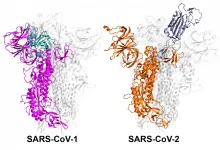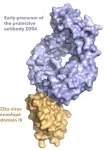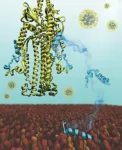Microscopic behavior of developing breast cells uncovered
An improved high-tech fluorescence microscopy technique is allowing researchers to film cells inside the breast as never seen before
2021-02-25
(Press-News.org) An improved high-tech fluorescence microscopy technique is allowing researchers to film cells inside the breast as never seen before.
This new protocol provides detailed instructions on how to capture hi-res movies of cell movement, division and cooperation, in hard-to-reach regions of breast tissue.
The technology - called multiphoton microscopy - uses infrared lasers to illuminate fluorescently labelled breast cells without harming them, so that elusive cell behaviours can be observed within living tissue.
With the new method, WEHI researchers have revealed how breast cells rearrange, interact and sense their environment as the breast grows during development and recedes after lactation.
Cell imaging within living tissue has been achieved in many organs but the breast has remained especially challenging. So far, this new method has revealed exciting and unexpected details of breast biology and will help teams worldwide to advance research on breast development and cancer.
At a glance
An improved imaging protocol is allowing researchers to film cells as never seen before.
This new application of high-tech microscopy has enabled the imaging of stem cells as they guide breast development, and immune cells as they monitor the breast ducts to keep them healthy.
By imaging living, moving cells in their natural setting, researchers can better understand how our bodies function in real-time at the microscopic scale.
Understanding cell function
The protocol was developed by researcher Dr Caleb Dawson, in a team led by Professor Jane Visvader and Dr Anne Rios, in collaboration with Dr Scott Mueller from the Doherty Institute, and published in Nature Protocols today.
Dr Dawson said the filming technique unlocked a variety of applications to better understand how cells function, interact and develop.
"One of the most valuable things we have been able to film with the technique are the terminal end buds (TEBs) in breast tissue," he said.
"These are club-like structures at the tips of the mammary ducts that grow during puberty to produce the branched tree structure of breast tissue. The unique cells inside the TEBs have never been filmed like this before so it was fascinating to watch this process for the first time."
"We have watched a cell behaviour inside the TEB that was hypothesised in the 1980s but was never proven, and which has implications for breast stem cell function."
Previously, TEBs had been studied by dissociating the individual cells and filming them outside the breast or by taking still images. With these approaches it is difficult to know how the cells actually behave and interact in living tissue.
"By filming the moving cells inside intact breast tissue in laboratory models, we are able to grasp a better understanding of how the cells behave and cooperate to help the breast to form and function properly."
Dr Dawson said that he was grateful for the brilliant team and the cutting-edge technology provided by the Center for Dynamic Imaging at WEHI that made this work possible.
"When we embarked on our mission to film these processes, I had little knowledge of the effort it would require. With the vision of leading breast researchers Professor Visvader, Dr Rios and Professor Geoff Lindeman, alongside the live imaging expertise of Dr Mueller, and the microscopes available, we were able to achieve something that very few labs in the world have accomplished," he said.
Opening the doors to new research opportunities
Dr Dawson said the filming technique could be applied to a host of research endeavours.
"Our approach enables us to image up to six fluorescent colours at the same time, which allows us to see how more cell types interact," he said.
"We can image different stages of breast development, immune cells, lymph nodes and hair follicles and watch how individually-labelled cells function."
"This means we can create beautiful images with extremely fine details about the cell shapes to get a better understanding of how cells interact and change over time. This opens up many new research opportunities and we are only just starting to see the potential of what this could be used for."
Dr Dawson said he hoped the imaging protocol would make this type of imaging more widely accessible to researchers.
"There are very few research institutions doing this really high-end imaging, so it is great that we have this capacity in Melbourne and can share it with research teams worldwide."
This work was made possible by the WEHI Center for Dynamic Imaging, with funding from the National Health and Medical Research Council, the Australian Government, National Breast Cancer Foundation, Australian Cancer Research Foundation and the Victorian Government.
INFORMATION:
ELSE PRESS RELEASES FROM THIS DATE:
2021-02-25
As the frequency and size of wildfires continues to increase worldwide, new research from Carnegie Mellon University scientists shows how the chemical aging of the particles emitted by these fires can lead to more extensive cloud formation and intense storm development in the atmosphere. The research was published online today in the journal Science Advances.
"The introduction of large amounts of ice-nucleating particles from these fires can cause substantial impacts on the microphysics of clouds, whether supercooled cloud droplets freeze or remain liquid, and the propensity of the clouds to precipitate," said Ryan Sullivan, associate ...
2021-02-25
Caught between climate change and multi-year droughts, California communities are tapping groundwater and siphoning surface water at unsustainable rates.
As this year's below-average rainfall accentuates the problem, a public-private partnership in the Monterey/Salinas region has created a novel water recycling program that could serve as a model for parched communities everywhere.
As Stanford civil engineers report in the journal Water, this now urbanized region, still known for farming and fishing, has used water from four sources -- urban stormwater runoff, irrigation drainage, food processing water and traditional municipal wastewater ...
2021-02-25
UNIVERSITY PARK, Pa. -- When healthcare workers become ill during a disease outbreak, overall case counts and mortality rates may significantly increase, according to a new model created by researchers at Penn State. The findings may help to improve interventions that aim to mitigate the effects of outbreaks such as COVID-19.
"Each year dozens of potentially lethal outbreaks affect populations around the world. For example, Ebola ravaged western Africa in 2014; Zika damaged lives in the Americas in 2015; and now we are in the midst of a worldwide pandemic -- COVID-19," said Katriona Shea, professor of biology and Alumni Professor in the Biological Sciences, Penn State. "Healthcare ...
2021-02-25
New York, NY (February 25, 2021) -- Early detection could reduce the number of African Americans dying from liver cancer, but current screening guidelines may not find cancer soon enough in this community, according to a study published in Cancer in February.
Black patients with liver cancer often have a worse prognosis than those of other racial and ethnic groups. Mount Sinai researchers sought to understand the reasons for this disparity by studying patients with hepatitis C, the leading driver of liver cancer in the United States.
Hepatitis C virus infection can result in cirrhosis, ...
2021-02-25
Feb. 25, 2021 - A new paper published online in the Annals of the American Thoracic Society provides a roadmap that critical care clinicians' professional societies can use to address burnout. While strongly needed prior to the COVID-19 pandemic, the roadmap has taken on even greater urgency due to reports of increasing pandemic-related burnout.
In "Professional Societies' Role in Addressing Member Burnout and Promoting Well-Being," Seppo T. Rinne, MD, PhD, of The Pulmonary Center, Boston University School of Medicine, and co-authors from a task force created by the Critical Care Societies Collaborative (CCSC) describe a rigorous process they used to document 17 major professional ...
2021-02-25
The Clalit Research Institute, in collaboration with researchers from Harvard University, analyzed one of the world's largest integrated health record databases to examine the effectiveness of the Pfizer vaccine against COVID-19. The study provides the first large-scale peer-reviewed evaluation of the effectiveness of a COVID-19 vaccine in a nationwide mass-vaccination setting. The study was conducted in Israel, which currently leads the world in COVID-19 vaccination rates.
The results of this study validate and complement the previously reported findings of the Pfizer/BioNTech ...
2021-02-25
Boston, MA - A new approach to pooled COVID-19 testing can be a highly effective tool for curbing the SARS-CoV-2 pandemic, even if infections are widespread in a community, according to researchers at Harvard T.H. Chan School of Public Health and the Broad Institute of MIT and Harvard. Simple pooled testing schemes could be implemented with minimal changes to current testing infrastructures in clinical and public health laboratories.
"Our research adds another tool to the testing and public health toolbox," said Michael Mina, assistant professor of epidemiology at Harvard Chan School and associate member of the Broad. "For public health agencies and clinical laboratories ...
2021-02-25
ROCKVILLE, MD - Coronavirus outbreaks have occurred periodically, but none have been as devastating as the COVID-19 pandemic. Vivek Govind Kumar, a graduate student, and colleagues in the lab of Mahmoud Moradi at the University of Arkansas, have discovered one reason that likely makes SARS-CoV-2, the virus that causes COVID-19, so much more infectious than SARS-CoV-1, which caused the 2003 SARS outbreak. Moradi will present the research on Thursday, February 25 at the 65th Annual Meeting of the Biophysical Society
The first step in coronavirus infection is for the virus to enter cells. For this entry, the spike proteins on the outside of ...
2021-02-25
ROCKVILLE, MD - The Zika outbreak of 2015 and 2016 is having lasting impacts on children whose mothers became infected with the virus while they were pregnant. Though the numbers of Zika virus infections have dropped, which scientists speculate may be due to herd immunity in some areas, there is still potential for future outbreaks. To prevent such outbreaks, scientists want to understand how the immune system recognizes Zika virus, in hopes of developing vaccines against it. Shannon Esswein, a graduate student, and Pamela Bjorkman, a professor, at the California Institute of Technology, have new insights on how the body's antibodies attach to Zika virus. Esswein will present the work, which was published in PNAS, on Thursday, February ...
2021-02-25
ROCKVILLE, MD - If the coronavirus were a cargo ship, it would need to deliver its contents to a dock in order to infect the host island. The first step of infection would be anchoring by the dock, and step two would be tethering to the dock to bring the ship close enough that it could set up a gangplank and unload. Most treatments and vaccines have focused on blocking the ability of the ship to anchor, but the next step is another potential target. New research by Defne Gorgun, a graduate student, and colleagues in the lab of Emad Tajkhorshid at the University of Illinois addresses the molecular details of this second step, which could inform the design of drugs that block it. Gorgun will present her research on Thursday, February 25 at the ...
LAST 30 PRESS RELEASES:
[Press-News.org] Microscopic behavior of developing breast cells uncovered
An improved high-tech fluorescence microscopy technique is allowing researchers to film cells inside the breast as never seen before



